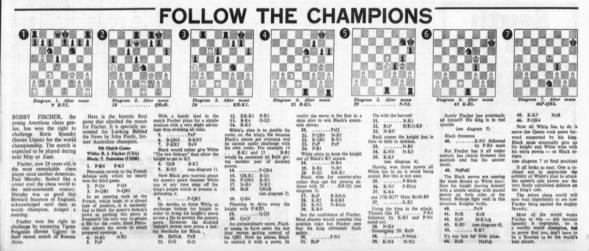The Sydney Morning Herald Sydney, New South Wales, Australia Tuesday, November 23, 1971 - Page 17
Follow The Champions
Bobby Fischer, the young American chess genius, has won the right to challenge Boris Spassky (Soviet Union) for the world championship. The match is expected to be played during next May or June.
Fischer, now 28 years old, is the most remarkable chess player since another American, Paul Morphy, flashed like a comet over the chess world in the mid-nineteenth century. Morphy was so good that Howard Staunton of England, acknowledged until then as world champion, dodged a meeting.
Fischer won the right to challenge by trouncing Tigran Petrosian (Soviet Union) in their recent match in Buenos Aires.
Here is the historic final game that clinched the match for Fischer. It is specially annotated for Looking Behind the News by John Purdy, former Australian champion.
Robert James Fischer vs Tigran Vartanovich Petrosian Fischer - Petrosian Candidates Final (1971), Buenos Aires ARG, rd 9, Oct-26 French Defense: Normal Variation (C10) 1-0 https://www.chessgames.com/perl/chessgame?gid=1044354
1. e4 e6
Petrosian reverts to the French defence with which he nearly won the third game.
2. d4 d5
3. Nc3 Nc6
In an opening such as the French, which leads to a closed type of position, it is normally bad to block the queen's bishop's pawn as pushing this pawn is frequently the only way to obtain a file for the rooks. Here Petrosian adopts the move to avoid prepared openings.
4. Nf3 Nf6
5. exd5 …
With a handy lead in the match Fischer plays for a simple position with a very slight advantage thus avoiding all risks.
5. … exd5
6. Bb5 Bg4
7. h3 Bxf3
Black would rather give White “The two bishops” than allow the knight to get to K5.
8. Qxf3 Be7
9. Bg5 (see diagram 1)
Now Black gets worried about his queen's pawn because White can at any time snap off the king's knight which at present is defending it.
9. … a6
He decides to force White to exchange bishop for knight in order to bring his knight's pawn across a file to protect the queen's pawn. However the doubled bishops pawns now prove a lasting headache for Black.
10. Bxc6+ bxc6
11. O-O O-O
12. Rfe1 h6
13. Bh4 Qd7
14. Re2 …
White's plan is to double his rooks on the king's file because Black's pieces are cramped and he cannot easily challenge with his own rooks. For example 14. … R-K1 and 15. … B-B1 would be answered by BxN giving another pair of doubled pawns.
14. … a5
15. Rae1 Bd8
16. b3 Rb8
17. Na4 Ne4
18. Bxd8 Rbxd8
(see diagram 2).
19. Qf4 …
Planning to drive away the knight with P-KB
19. … Qd6
20. Qxd6! …
An extraordinary move, Fischer seems to have spent the last four moves getting control of his QB5. Now he allows Black to control it with a pawn. In reality the move is the first in a deep plan to win Black's queen-side pawns.
20. … cxd6
21. c4 Nf6
22. Rc1 Rb8
23. cxd5 cxd5
24. f3 …
White plays to keep the knight out of Black's K5 square.
24. … Nh5
25. Rc6 Nf4
26. Rd2 Rfe8
Black tries for counter-play rather than opt for passive defence with 26. … KR-Q1 (see diagram 3).
27. Rxd6 Re1+
28. Kf2 Rh1
29. Kg3 Nh5+
30. Kh4 …
See the confidence of Fischer. Most players would consider this position risky but Fischer sees that his king ultimately finds safety.
30. … g6
31. Rxd5 …
31. …
On with the harvest!
31. … Re8
32. Rxa5 Ree1
33. Nc3 Nf4
34. Kg4 Ne6
35. Re5 …
Having won three pawns all White has to do is avoid being mated. But this is not easy.
35. … f5+
36. Kg3 f4+
37. Kh4 …
not 37. K-B2?? Mate R(r8)-B8
37. … Kh7
Using the king in the attack. Threats like 38. … P-R4 followed by K-R3 and P-N4 stand out.
38. Ne4 …
threatening 39. RxN
38. … g5+
39. Kg4 Ng7
Surely Fischer has oveerreached himself! His king is in real trouble (see diagram 5). Black threatens 40. … K-N3 followed by P-R4 mate. But Fischer has it all under control, has clearly foreseen this position and has his answer ready.
40. Nxg5+ …
The Black pawns are causing the mate threats so White sacrifices his knight leaving himself with a simple ending with passed pawns on both sides of the board. Bishops fight well in this situation. Knights badly.
40. … hxg5
41. Rxe1 Rxe1
42. Kxg5 Ne6+
43. Kf5 (see diagram 6)
43. … Re2
It's too late for little jokes.
44. Rxe2 Nxd4+
45. Ke5 Nxe2
46. a4
Now all White has to do is move the Queen rook pawn forward supported by his king. Black must eventually give up his knight and White wins with his extra pawns — so Black resigns. (see diagram 7 of final position).
It all looks so easy. One is inclined not to appreciate the subtlety of White's plan to attack the queen's side pawns nor the very finely calculated defence on the king's side.
The entire chess world will now wait impatiently to see how Fischer fares against the mighty Spassky.
Most of the world wants Fischer to win — not because Spassky is unpopular, he is a worthy world champion, but to prove that you don't have to be a Russian to be the world's best player.
 Follow The Champions Tue, Nov 23, 1971 – Page 17 · The Sydney Morning Herald (Sydney, New South Wales, Australia) · Newspapers.com
Follow The Champions Tue, Nov 23, 1971 – Page 17 · The Sydney Morning Herald (Sydney, New South Wales, Australia) · Newspapers.com






















